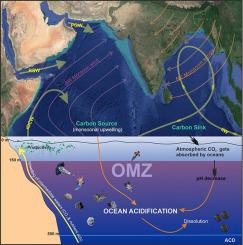Journal of Asian Earth Sciences ( IF 3 ) Pub Date : 2021-07-27 , DOI: 10.1016/j.jseaes.2021.104904 Rajani Panchang 1 , Mugdha Ambokar 1

|
Characterised by one of the largest fresh water influxes in the world, the Northern Indian Ocean (NIO) is also bathymetrically, hydrodynamically and climatologically fragmented into smaller basins, making it a complex ocean basin. The monsoon system is unique to the NIO, bringing in several processes like ocean warming, dissolved oxygen depletion, evaporation, freshwater runoff induced by precipitation as well as glacial melting, nutrients derived from land runoff as well as coastal upwelling, biological productivity, oxic-degradation of organic matter and formation of oxygen minimum zones, all functional together at any given time. The seasonality and magnitude of all these processes control the pH in the NIO, as against other global oceans wherein only one or a couple of these processes are in play. The thermohaline circulation is another process that continuously affects the water chemistry in the NIO and has varied in strength over glacial-interglacial cycles. Its interaction with the NIO has the potential of affecting water masses in other ocean basins as well. While there exists limited work in the NIO directly addressing the issue of ocean acidification, substantial research has been done to understand the different hydrological and climatological processes, which influence the acidity in the basin. The present review summarises such studies which offer significant clues to the processes leading to- and impacts of- ocean acidification in the NIO. However, ocean acidification studies are in their nascent stage in the NIO. Understanding the influence of thermohaline ventilation in the Bay of Bengal, interbasinal hydrological teleconnections, impacts of ocean acidification on different trophic levels of the food chain, estimation of anthropogenic CO2 flux, estimation of pre-industrial pH and dissolution horizons by collating past chemical metrics collected, study of submarine volcanic regions as mimics of climate change and qualitative / quantitative ecosystem responses / adaptations are all promising prospects for further study in the Northern Indian Ocean.
中文翻译:

北印度洋的海洋酸化:综述
北印度洋 (NIO) 以世界上最大的淡水流入量之一为特征,在测深、水动力和气候方面也被分割成较小的盆地,使其成为一个复杂的海洋盆地。季风系统是 NIO 独有的,它带来了几个过程,如海洋变暖、溶解氧耗竭、蒸发、降水和冰川融化引起的淡水径流、陆地径流和沿海上升流产生的养分、生物生产力、有氧有机物的降解和氧最低区的形成,所有这些都在任何给定时间共同发挥作用。所有这些过程的季节性和大小控制着 NIO 中的 pH 值,而其他全球海洋中只有一个或几个这些过程在起作用。温盐环流是另一个持续影响 NIO 中水化学的过程,并且在冰期-间冰期循环中强度不断变化。它与 NIO 的相互作用也有可能影响其他海洋盆地的水团。虽然 NIO 直接解决海洋酸化问题的工作有限,但已经进行了大量研究以了解影响盆地酸度的不同水文和气候过程。本综述总结了这些研究,这些研究为 NIO 中导致海洋酸化及其影响的过程提供了重要线索。然而,海洋酸化研究在 NIO 中处于起步阶段。了解孟加拉湾温盐通风的影响,2通量、通过整理过去收集的化学指标来估计工业化前的 pH 值和溶解范围、研究海底火山区作为气候变化的模拟以及定性/定量生态系统响应/适应都是北印度洋进一步研究的有希望的前景。


























 京公网安备 11010802027423号
京公网安备 11010802027423号